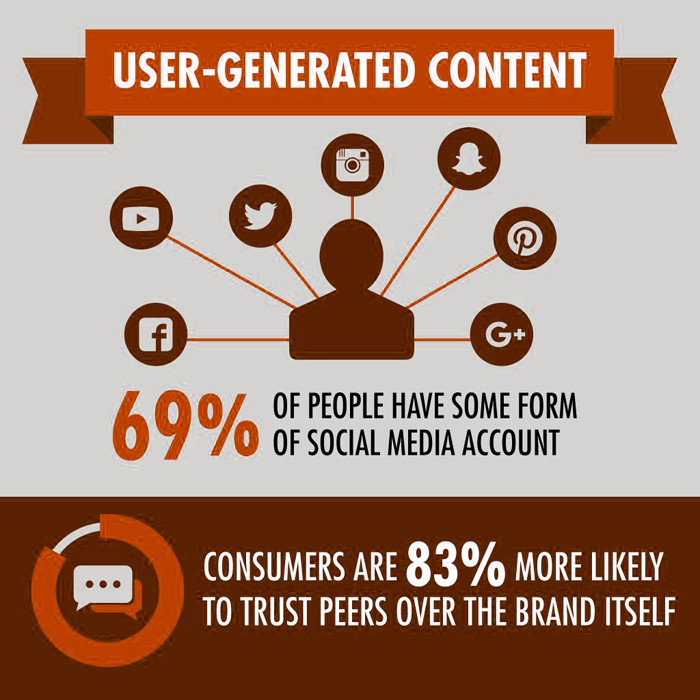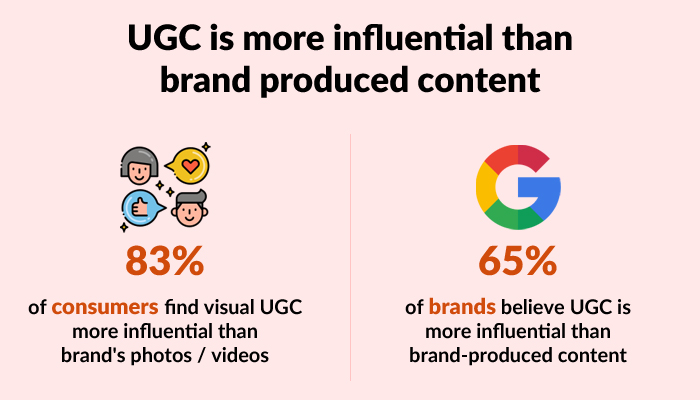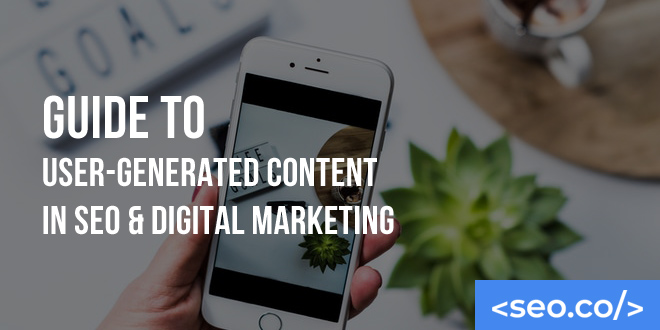Content is the currency of digital marketing. It doesn’t matter if you’re a solo entrepreneur selling a tiny niche product or a global corporation with an international marketing department that’s tasked with reaching millions of people – content is non-negotiable.
But content is expensive, time-consuming, and requires a constant supply of creativity. And if you’re dealing with limited resources, it can be challenging to constantly develop brand new content day after day and week after week.
Thankfully, there’s a solution that does some of the heavy lifting for you. It’s something marketers call user-generated content, and it has the potential to take your marketing to the next level.
Table of Contents
What is User-Generated Content?

User-generated content – sometimes referred to as UGC – is any type of digital content that’s made, produced, and shared by a customer or user. In other words, it’s any piece of content that’s not made by your brand (but that can be leveraged to benefit your brand in some form or fashion).
Common types of user-generated content include:
- Social media content. Social media is by far the richest source of UGC. Not only does it give you a large supply of content, but it’s also perceived as the most genuine and trustworthy type of user-generated content. Whether it’s an image of a customer wearing one of your products in an Instagram photo or a product tutorial video on YouTube, social media content is an amazing addition to any content strategy.
- Blog comments. If you have a blog on your website, mine the comments for useful little nuggets. Anything a reader writes can be turned into UGC with a little creativity. It could be as simple as taking a screenshot and sharing it on social media.
- Blog posts. As your online brand grows, you may find that other people are talking about your products and services on their own blogs. Sometimes this happens naturally, but you can also proactively send products to bloggers as a way of encouraging them to write about your brand.
- Reviews and testimonials. When a customer publishes a review or testimonial about their experience with your business, this is a form of user-generated content that can be leveraged and deployed in other ways. (You just have to make sure you have the legal right to use the content based on where it was published.)
Some brands have products and services that are more conducive to user-generated content than others, but there’s plenty of room to get creative. Whether you’re selling paper towels or Ferraris, UGC is a practical and valuable addition to any content strategy.
The Benefits of User-Generated Content

User-generated content is an absolute no-brainer for brands small and large. Here are a few of the most common benefits businesses enjoy when they integrate UGC into their content strategies:
- Increased trust. Did you know that 88 percent of customers trust online reviews as much as they trust people they know in their everyday lives? Or that two-thirds of consumers seek out the opinions of others online before making purchases? In other words, UGC is viewed as much more trustworthy and transparent than anything a brand could ever publish on its own.
- Greater influence. Approximately 75 percent of customers rely on social media content in their purchase decisions, while 84 percent of millennials say UGC impacts their buying choices. Almost all customers say user-generated photos of products are more useful than professional photos. When you put it all together, the message is clear: User-generated content is more influential than anything a brand creates in a boardroom or studio.
- Lower costs. There’s clearly a financial advantage to UGC. Take product photos as an example. It could cost anywhere from $1,000 to $10,000 or more for a single product photoshoot with a professional photographer. But for nothing more than the cost of goods, you could send products out to a few dozen customers and ask them to share pictures of them using the products. The same goes for blog posts. While it might cost you $100 to $200 to pay a copywriter to produce a simple blog post, you can set up a guest contributor program and have people submit content to your blog for free.
- Time savings. In addition to the cost savings, user-generated content provides rather significant time savings. For example, it could take you as long as three or four hours to write and publish a blog post. If you were to collect just one guest blog post submission every week, that amounts to as much as 12 to 16 hours saved every single month.
If you aren’t currently leveraging user-generated content, you’re missing out on a massive opportunity to increase trust and influence with your audience while simultaneously reducing the amount of time and money you invested into content creation. We highly encourage you to give it a chance.
Developing a User-Generated Content Strategy

User-generated content is best utilized as part of a larger content strategy. Here are a few specific tips you can use to begin integrating it into your marketing plan:
1. Get Active on Social Media
This isn’t the sexiest piece of advice – particularly when you’re looking to save time and money – but your best chance of harvesting a bunch of UGC is to be active on social media. The more you create content, the more others will be willing to do the same.
People like things they’re familiar with. If your followers see your content popping up in their feeds every single day, they’re going to naturally feel more comfortable with you. On the other hand, if you only post something every few weeks when you want to push a new promo, that likability factor will be much lower.
As you post on social media, come up with a very clear style. Whether it’s the type of filters you use, the colors, the tone of the copy, or the hashtags, consistency breeds familiarity. You want people to see your content and instantly associate it with you. Once you accomplish this, you’re at a point where people are engaged enough to respond in a manner that positively impacts your brand.
2. Identify Your Biggest Fans
Another benefit of being active on social media is that it allows you to see who your biggest followers are. More specifically, you’ll discover things like:
- How they talk and communicate
- What their interests and hobbies are
- What they like to do on the weekends
- What other brands they follow and/or products they use
All of this information can be used to develop better branded content. However, it can also be utilized to make a shortlist of the customers who are most likely to generate UGC for you. So rather than going after all 10,000 of your followers, you can narrow in on the 50 to 75 followers who are most engaged.
3. Make it Easy for People to Share
The easier you can make it for people to share user-generated content, the more likely it is that they’ll actually take the time to do it. Here are some ways to simplify the UGC process:
- Create simple step-by-step instructions and share them with your followers. For example: (1) Take a picture with yourself using the product, (2) Share the picture on your account using this #hashtag, (3) Tag our account so that we can give you a shout-out!
- Hashtags are a really great way to find UGC content. Create a unique hashtag that’s reserved for this purpose. Then even if someone forgets to tag you, you’re able to run a search and find the content they published.
- If you’re collecting guest blog posts, create a very simple checklist that explains exactly what you want. This may include headline requirements, word count, rules regarding backlinks, topics that are prohibited, recommended topics, etc.
You never want one of your followers to feel uncertain of how to share content. Remove any confusion and make it super easy.
4. Look Elsewhere
Social media isn’t the only place to collect user-generated content. There are plenty of other places around the web where you can look – even if it isn’t coming directly from your customers or followers.
Let’s say you have your own clothing brand that sells apparel designed for hiking, fishing, and camping. In addition to gathering UGC from your customers, you can browse other websites for other original content.
A hiking subreddit, for example, might be full of pictures, videos, and tales of unique hiking experiences.
You can also perform a competitive content gap analysis to provide ideas.
There are plenty of ways to creatively leverage these resources,
5. Know How to Use It
Once you collect user-generated content, you need to know how to use it for maximum impact. Generally speaking, there are three specific ways to use user-generated content on social media:
- Create brand desire. When social media users see other users posting content about their positive experiences with your products, it creates a sense of desire in their minds. This can be used to pull new people into your brand and drive sales.
- Showcase loyalty. UGC acts as a form of social proof. The more your followers see other people using and enjoying your products, the more loyal they’ll become.
- Build out your content library. Sometimes you just need content to share in order to keep your followers engaged. You can use UGC to develop an inventory of content that’s easy to share on a predictable schedule.
There may be some overlap in these areas, but you get the idea. Every piece of UGC you share should be creating brand desire, showcasing loyalty, and/or building out your content library. If it’s not, you’ll need to reconsider what you’re doing.
6. Be Clear About What You’re Looking For
Research shows that just 16 percent of brands offer clear guidelines or expectations regarding the type of user-generated content they want their customers and fans to create. That might not seem like a very big deal, except for the fact that more than 50 percent of customers want brands to tell them what they want.
Don’t be afraid to tell your customers what you want. By giving out specific guidelines and instructions, you actually make it a lot easier on them. You remove decision fatigue and allow them to simply create. That’s a big win that will amplify your UGC efforts down the road.
7. Incentivize Content Creators
Many brands eventually reach a point where their customers create content without being prompted. However, it can take some time to get there. For most smaller brands, there has to be some sort of nudge or kick in the rear.
If you’re having trouble attracting UGC, try running a social media contest with a prize. A classic photo-sharing contest with a simple hashtag works great.
The key with social media contests is to share as much of the UGC that you collect as possible. This does two things. First, it strengthens the relationship with that individual customer. Second, it motivates other people that follow you to share their own content. (Who doesn’t like being featured?)
8. Give Credit Where Credit is Due
The golden rule of user-generated content is to always, always, always give credit to the original creator. Tag them directly in the post, mention their name, and say something nice about them. This prevents any sort of complicated issue where a user could come back at you and claim that you stole their content. (This is unlikely to happen, but it’s a good safety net.) It’s also just the right thing to do!
9. Study What Other Brands Do
You don’t always have to reinvent the wheel. Sometimes the best thing you can do is study what other brands are already doing and mimic their approach. Many leading brands like Nike and Coca-Cola have exceptional UGC strategies that you could learn from. Even though they have massive audiences, the same principles can be applied to your brand on a much smaller scale.
Understanding the Limitations of UGC
In some cases, user-generated content is not the catchall solution outlined in many of the aforementioned scenarios.
What if you want to maintain control of your content, like in the case of a regulated industries like those in financial services or law?
Or perhaps you’re simply anal about filtering all of your content before it is published?
In such cases, the sheer magnitude of filtering what other people say can make the cost of offering UGC, greatly outweigh the benefit. Knowing the limitations of UGC will be critical in assessing its fit with your business as a strategy for scaling content, users and sales.
Build Out Your Full Content Strategy
User-generated content isn’t going to carry your entire marketing campaign. It can, however, prove to be a powerful component of a much larger strategy. When leveraged in conjunction with other types of content, it packs a very powerful punch.
At SEO.co, we specialize in helping growing digital brands scale their organic traffic with quality content marketing with high-quality content and pristine links. We do this through white hat, contextual link building, premium content marketing, and industry-leading PR news and blogger outreach.
If you’re interested in expanding your digital marketing presence with a greater emphasis on content, we would love to help you achieve your goals. Contact us today and we’ll be happy to discuss a few options that make the most sense for your business!
Tim holds expertise in building and scaling sales operations, helping companies increase revenue efficiency and drive growth from websites and sales teams.
When he's not working, Tim enjoys playing a few rounds of disc golf, running, and spending time with his wife and family on the beach...preferably in Hawaii.
Over the years he's written for publications like Forbes, Entrepreneur, Marketing Land, Search Engine Journal, ReadWrite and other highly respected online publications. Connect with Tim on Linkedin & Twitter.
- Content Marketing: Using Content & SEO to Grow Your Business [Complete Guide] - October 23, 2024
- SEO for Labor and Employment Lawyers: Top Tactics to Rank - October 4, 2024
- How to Find & Fix Duplicate Content on Your Website - September 24, 2024



